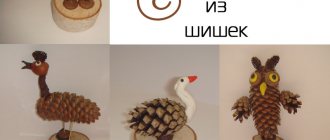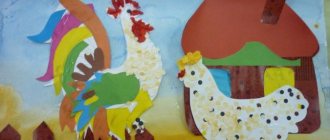Types of design, materials for children's design.
Common types:
1 Fine
– carries an aesthetic meaning (garland for the New Year);
2 Technical
– for practical purposes (house for a doll).
Types of design based on the material used
:
1
Construction from building material.
2
Made of paper and cardboard (origami, star).
3
From natural material (from acorns, cones, sand, snow).
4
Made from waste material (paralon, foam, etc.).
Types of constructive activities in different age groups of preschool institutions.
1 According to the example and demonstration of the teacher.
It is carried out from teens to pre-school age.
2 Based on sample without display
. Conducted from middle age.
3 According to drawing or picture
. Conducted from 100 years of age. Classes are based on visual modeling. First, children are taught to draw up diagrams of buildings, and then, on the contrary, to make buildings according to the diagrams.
4 According to conditions
. Introduced from middle childhood. The teacher does not give a model, but explains to the children the conditions that the building or craft must meet.
5 On the proposed topic
. Introduced from middle childhood. The teacher gives only the topic. For example, build a city street.
6 By my own design
. Introduced from the end of middle childhood. Children themselves determine the theme of construction.
Design tasks
(
in younger groups):
1
To promote the emergence and development of positive emotions and interest in playing with building materials.
2
Enrich children's understanding of color and shape.
3
Develop children's spatial orientation.
4
Learn to examine and analyze a sample.
Learning objectives (at preschool age):
1.
Promote the development of interest in architecture, design and constructive activities.
2.
To support and stimulate interest in independent construction in children's games.
3.
To introduce the rational and appropriate use of building and natural materials.
Learning objectives (at preschool age):
1.
Develop an emotional attitude towards architecture, design and various crafts.
2.
Teach children to create buildings and crafts according to given conditions, diagrams and drawings.
3.
Promote independent development of constructive activities.
41. Methods of teaching design in different age groups of kindergarten.
Activities in younger groups, their playful nature. Teaching methodology.
Construction is carried out from building materials (cubes, bricks) and natural (snow, sand).
First, children build simple buildings: a tower, a staircase, a bridge. Then each building is played out. Building materials are used for work both in groups and outdoors.
Methods and techniques:
observation, example of a teacher, examination, demonstration of methods of action, exercises in action, game techniques, verbal methods.
Contents and methods of conducting design classes in middle school age.
Contents of design.
They begin to use all 4 types of design. Constructions made from building materials become more complex: they make entire rooms for dolls, city streets.
They are introduced to a new construction material – paper. They teach how to fold rectangular sheets in half and square sheets diagonally. The theme is still simple: they make boxes, airplanes, and a garland of rings.
They begin to make crafts from cones, bark, acorns, and nut shells. Fastening the parts with plasticine.
They teach how to make toys from polystyrene foam and paralon.
Methods and techniques:
observation, example of a teacher, examination, demonstration of methods of action, exercises in action, game techniques, verbal methods.
Contents and methods of conducting design classes at preschool age.
Contents of training.
When working with building materials, children pay attention to the strength and stability of the structure and its aesthetic appearance.
When designing, various shapes are used - plates, bars, cylinders, prisms (roof).
Children more often build collective buildings. In paper construction, toys are made from cylinders and cones. They make a variety of toys using the origami technique, complex garlands, and stars for the New Year.
Crafts made from natural materials are becoming more complex, they consist of a larger number of parts, and can convey movement.
Working from waste material becomes more difficult. Children make not only toys, but also towers from matchboxes, thread spools, and toys from plastic bottles.
Methods and techniques:
observation, teacher model (rarely used), examination, demonstration of methods of action, exercises in action, game techniques, verbal, research and heuristic methods.
42. Variable programs and pedagogical technologies for the artistic and creative development of preschool children.
The proposed technology highlights the artistic and creative development of preschool children, the formation of aesthetic needs and abilities, and the development of cultural forms of communication with art by preschoolers as the main target guidelines.
The technology involves meaningful specification of the tasks of artistic and aesthetic education at different stages of preschool childhood.
The main objectives of the technology for the artistic and creative development of preschool children include:
1. Development of artistic perception.
2. Formation of aesthetic feelings and emotions.
3. Development of the child’s imagination, thinking, memory and speech.
4. Introduction to basic knowledge in the field of art.
5. Development of children's creative abilities in different types of artistic creativity.
6. Formation of the foundations of artistic and creative culture of the individual.
Conceptual provisions for the technology of artistic and creative development of a preschool child were developed by N.A. Vetlugina, T.S. Komarova, A.V. Antonova, M.B. Zatsepina and others.
T.S. Komarova notes that in all types of artistic and aesthetic activity, general mental processes can be identified, which are the basis for the formation of artistic creativity and artistic and creative abilities. These processes include:
- perception, the images of which, accumulating, form sensory experience, which serves as the basis for the development of various abilities, including artistic and creative ones. On the basis of images of perception, ideas are formed. If the images of perception are aesthetically colored, then the ideas formed on their basis will also be aesthetic. This is greatly promoted by the use of all kinds of arts;
- imagination, without which no artistic and creative activity is possible and which, in turn, develops in the process of this activity;
- an emotionally positive attitude towards objects of aesthetic perception, necessary for the successful implementation of activities. Attitude arises when the activity contributes to the satisfaction of needs that are significant for the child, primarily in knowledge, self-affirmation and meaningful communication with adults and peers;
— the effectiveness of the development of artistic and creative abilities largely depends on the formation of artistic skills in the field of various arts: drawing, modeling, artistic design, singing, expressive movements and verbal creativity;
— children need to be taught artistic creativity by creating problem situations and using a system of creative tasks.
^ The mechanism for transferring and mastering the experience of artistic and creative activity has been developed within the framework of the following scientific concepts:
1. Associative - reflexive concept of learning (I.P. Pavlov, I.M. Sechenov, S.L. Rubinstein).
Based on the basic concepts of conditioned reflex activity of the brain.
The highest results in training are achieved when the following conditions are met:
— formation of an active attitude towards cognitive activity;
— presentation of educational material in a certain sequence, step by step;
— demonstration and consolidation of material in various methods of mental and practical activity;
- application of knowledge in practice.
2. Developmental technology (L.S. Vygotsky, D.B. Elkonin, V.V. Davydov).
Developmental technology assumes that the organization (content and methods) of external influences can significantly change the pace and boundaries of a child’s development.
Assimilation of experience occurs in the following sequence:
— preliminary acquaintance with the action, orientation, motivation for activity;
- material (materialized) action;
— stage of external speech, voicing actions, formulating conclusions;
-stage of internal speech, understanding the problem;
-stage of automated action (skill).
The authors of the technology have developed principles for its implementation:
— the principle of taking into account age and individual characteristics presupposes an approach that opens up the prospect of artistic and aesthetic development of each child in accordance with his level of abilities and age-related capabilities;
— the principle of the simultaneous inclusion of all analyzers in the process of cognition of any value ensures the strength of conditioned connections in the cerebral cortex and the activity of all mental processes;
— the principle of integration of various types of arts and various types of artistic and creative activities of children contributes to a deeper aesthetic understanding of reality, art and their own artistic creativity, the formation of imaginative ideas, imaginative, associative thinking and imagination;
— the principle of accessibility involves managing the pace and content of a child’s development through the organization of educational interventions;
— the principle of productivity emphasizes the pragmatism of the method, the obligatory orientation towards obtaining a meaningful, real, complete result for the child;
— the principle of the relationship between the artistic and creative activities of children and educational work creates conditions for the formation of diverse ideas and expands the experience of perception, stimulates the development of imagination and creativity;
— the principle of variability and spiraling. The variability of the content, forms and methods of working with children makes it possible to realize the value of the arts in different types of activities and in different ways, from the particular to the general, from the general to the particular;
— the principle of effectiveness presupposes a respectful attitude towards the results of children’s creativity, the widespread inclusion of their works in the life of a preschool educational institution, the organization of exhibitions, concerts, etc.
Process characteristics of technology
The technology of artistic and creative development of preschool children can be represented as a way of organizing the pedagogical process, based on the development of children's activity, respectful attitude towards requests and needs, and maximum assistance to the development of the child as a creative personality. The child is considered as a full participant in the educational process, the adult acts as a person interested in cooperation with the child. An adult supports his initiative when discussing or doing various things. The child is endowed with authority and at the same time responsibility for completing the assigned task.
One of the important tasks of artistic and creative activity is to teach children to evaluate their own work and the work of their peers, highlight the most interesting artistic and visual solutions, express aesthetic assessments and judgments, and strive for meaningful communication related to artistic and creative activity.
The process of becoming a creative personality has its own algorithm.
The first element is the accumulation of impressions from the perception of the arts, which are a model for creativity, a source of inspiration and motives for future activity.
The second element is the accumulation of experience in practical activities and the development of knowledge, skills and abilities of a reproductive nature. The necessary skills and abilities allow the child to express his own impressions in an artistic and creative form.
The third element is a cycle of creative tasks that vary and become more complex: from tasks that require initial orientation in creative activity, to tasks that facilitate the development of methods of creative action, search for solutions, and, finally, to tasks designed for independent actions of children.
The main stages of the technology of artistic and creative development of preschool children:
^ The first stage is the accumulation of sensory, emotional, intellectual experience as the fundamental basis for creativity. Important points at this stage are information- and aesthetically-enriched spaces (developmental environment) and motivational stimuli that awaken active creative activity.
^ The second stage is the stage of imitation, imitation - mastering the standards of creative activity, its methods, technologies and means. The main thing at this stage is the activation of the child’s existing experience in an aesthetically complete, polyartistic space.
^ The third stage is the stage of transformation - the use of mastered standards and their transformation in new, personally significant conditions in accordance with the individual characteristics, capabilities, and abilities of children.
^ The fourth stage - the stage of alternatives - is aimed at individualization, harmonization of creative activity, the formation of creative individuality, expressiveness and uniqueness in the creation of artistic images.
Methods and techniques of technology for the artistic and creative development of preschool children: visual (auditory and visual clarity), verbal, method of problem, search situations, practical methods, game method.
Thus, the technology of artistic and creative development of preschool children is considered as a way of organizing the pedagogical process, based on the development of children’s activity, respect for requests and needs, and maximum assistance to the development of the child as a creative personality. The child is a full participant in the educational process, the teacher acts as a person interested in cooperation with the child. The adult supports the pupils' initiative when discussing or performing various tasks. The preschooler is endowed with authority and at the same time responsibility for completing the assigned task.





